|
If your email program has trouble displaying this email or certain images, view as a webpage. |
|
|
Back to TOP

 Image courtesy DOD.
The FDA’s China Office (CNO) is helping to protect the U.S. public from potentially unsafe laser products manufactured in China.
Laser products are overseen by the FDA’s Center for Devices and Radiological Health (CDRH). All laser manufacturers are required to disclose safety specifications and testing methods to the CDRH prior to entering the U.S. market. However, laser manufacturers in China are notorious for submitting low-quality or incomprehensible reports due to a misunderstanding of the regulations and/or a desire to avoid FDA oversight. This includes manufacturers that import everything from desktop laser engravers to room-sized industrial laser cutting machines. When CDRH tries to follow up for additional information, it is commonly stymied by a combination of intermediary consultants, incorrect contact information, and a formidable language barrier.
Chinese laser manufacturers are typically small and transitory, leading to unfamiliarity with international regulations and heavy reliance on outside experts. Further, unethical consultants may aim to shield their customers from direct FDA communications to obfuscate the service they claim to provide. The CDRH regularly requests assistance with the most challenging unresponsive or seemingly noncompliant laser firms.
The CNO’s locally employed (LE) staff helps out by researching these manufacturers based on information found in the CDRH’s reporting systems, obtaining contact information for personnel within the company, and ensuring receipt of otherwise undeliverable CDRH letters. While communicating with the companies, the LE staff emphasize the importance of interaction and compliance with the FDA.
When appropriate, FDA International Relations Specialist Scott Gonzalez participates in teleconferences with the Chinese companies to explain the technical details of FDA safety and quality regulations, conveying not only the importance of doing so but how simple it is to comply with FDA’s requests. During these exchanges, Scott also describes the problems that may arise from utilizing untrustworthy consultants. The CNO is currently assisting with 11 laser companies in China.
By briefly searching publicly available websites in Mandarin and making a few local phone calls, CNO is able to drastically reduce the number of “firm unreachable” conclusions. Not counting the 11 companies it is now helping, CNO estimates it has saved CDRH $1,500 in United Parcel Service failed delivery fees and 35 hours of labor assisting 13 previous laser firms in fiscal year 2022 alone. The CNO’s customer service-oriented attitude — coupled with its dedicated LE staff — supports the FDA’s international regulatory work in many ways that may easily go unnoticed. This collaborative effort also demonstrates how employing in-country staff familiar with local culture and languages uniquely enhances the FDA’s presence overseas.
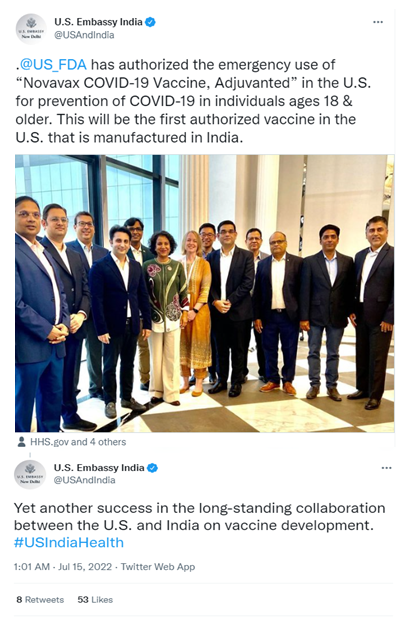
On July 13, the FDA issued an emergency use authorization (EUA) for the Novavax COVID-19 Vaccine, Adjuvanted for the prevention of COVID-19 caused by severe acute respiratory syndrome coronavirus 2 (SARS-CoV-2) in individuals 18 years of age and older.
A week later, on July 18, the U.S. Centers for Disease Control and Prevention (CDC) endorsed the vaccine following the Advisory Committee on Immunization Practices’ (ACIP) unanimous vote to recommend it as a two-dose primary series in individuals aged 18 and older. The CDC establishes its vaccine recommendations and schedules based on advice from ACIP.
The vaccine is manufactured for Novavax by the Serum Institute of India Pvt. Ltd. (SII), according to the FDA decision memo.
The SII is based in Pune, a city in the western Indian state of Maharashtra. The company was founded in 1966 and today is the world’s largest vaccine manufacturer by number of doses produced.
The U.S. Embassy in New Delhi marked the FDA’s EUA with a two-part tweet the day after the announcement.
Maryland-based Novavax said it expects to ship doses of the vaccine to the U.S. government-designated distribution center in the coming days.
|
Per- and polyfluoroalkyl substances (PFAS) are a diverse group of human-made chemicals used since the mid-twentieth century when various PFAS began to be produced for use in a wide range of consumer and industrial products, including in food packaging. PFAS do not easily breakdown and some types have been shown to accumulate in the environment and in our bodies. Exposure to some types of PFAS has now been scientifically linked to serious health effects.
One way that PFAS can enter the food chain is through environmental contamination. Typically, environmental contamination is limited to a specific geographic area, such as near an industrial facility where PFAS are produced or used to manufacture other products, or in other locations where PFAS-containing products are used for firefighting. PFAS can also enter the environment through discarded products in landfills. The use of soil, water, or biosolids contaminated with PFAS to grow crops, feed animals intended for food, or to raise fish or other seafood, can lead to PFAS entering the food supply.
Since 2019, the FDA has been testing for PFAS in foods originally collected as part of the FDA’s Total Diet Study (TDS), which surveys the general food supply. On July 6, the FDA posted results from a targeted seafood survey conducted in 2022, which was initiated by previous findings of relatively low levels of PFAS in a few seafood samples. This survey collected 81 samples at retail of clams, cod, crab, pollock, salmon, shrimp, tuna, and tilapia, most of which were imported to the United States. The percentage of seafood samples with detectable PFAS, the types of PFAS detected, and the levels detected in multiple samples were higher in this targeted seafood survey than found by the FDA in overall TDS samples.
Sixty of the samples had detectable levels of PFAS, with most samples having more than one type of PFAS detected. When the FDA finds detectable levels of PFAS in foods, the FDA conducts an assessment which considers a number of factors, including how much of the specific food people typically eat, the level of the contaminant detected in that food, and the toxicity of the contaminant, to evaluate whether the levels detected present a possible human health concern. At this time, there are six PFAS from environmental contamination for which the FDA can evaluate the potential human health concern for levels found in food. The FDA determined that of the PFAS evaluated, the estimated exposure to a type of PFAS, perfluorooctanoic acid, or PFOA, in the 10 canned clam samples from China are likely a health concern — with test results ranging from 2897 to 20,133 ng/kg, or parts per trillion. The levels of the other types of PFAS evaluated in the clams, as well as the PFAS evaluated for all other seafood samples are not likely to be a health concern.
 Getty Images.
In this survey FDA researchers tested for certain types of PFAS that have been identified in the scientific literature as being found in food and seafood. Other studies on clams from China and Europe have reported a range of levels of PFOA, including elevated levels.
Research has shown that exposure to PFOA is associated with several serious health outcomes, including developmental effects, changes to liver function, reduced immune response, and increases in certain types of cancer.
After learning the results of the FDA’s testing of their products, the two distributors of the samples with the two highest levels of PFOA took voluntary action to protect consumers. One company issued a voluntary recall of canned smoked clams. A second company followed with a voluntary recall of canned smoked baby clams that were included in the FDA’s testing.
The FDA is actively engaged with all the canned clam distributors that had products sampled to better understand potential sources of contamination, which could help the companies take action to reduce consumer exposure to PFOA from their products. The agency also plans to conduct broader testing of canned and fresh clams, both imported and domestically harvested, to better understand PFAS levels to determine the best approach for protecting public health. The results from our analysis of foods from the general food supply, along with other testing results, help to inform the FDA’s risk-based approach to identifying, prioritizing, and implementing the agency’s activities to reduce exposure to PFAS from human and animal food.
 Getty Images.
Recently, diminutive and slender enoki mushrooms from the Republic of Korea (ROK) are a bit harder to come by. On July 1, the FDA issued a countrywide alert for all raw and raw fresh refrigerated or frozen enoki mushrooms, including sliced, chopped, or diced enoki mushrooms, offered for importation into the U.S. from the ROK. The FDA has issued Import Alert #25-21 to help safeguard the public health of U.S. consumers, based on the high violation rate of enoki mushroom products from the ROK that are contaminated with Listeria monocytogenes (L. mono), a human pathogen.
Enoki mushroom products, as described above, may still be exported from the ROK to the United States. However, considering the high violation rate, entries of enoki mushrooms may be detained without physical examination (DWPE) until a firm provides evidence that their product does not bear or contain L. mono. Under the import alert, enoki mushroom products may be subject to DWPE unless the firm has met criteria for exemption from DWPE or addition to the Green List of the import alert. Such a countrywide import alert is used when there is an appearance of serious and continuing violations of a specific product class from a given country or region.
In fiscal year 2021, the FDA analyzed enoki mushrooms imported from a number of countries. The FDA analysis found that 43% of enoki mushrooms (sometimes labeled as "seafood mushrooms") sampled from the ROK were contaminated with L. mono. Additionally, an FDA investigation into a multistate outbreak spanning from 2016 through 2020 linked multiple cases of human L. mono infections (listeriosis) to enoki mushrooms from the ROK. The outbreak accounted for a total of 36 U.S. clinical cases reported across 17 states, 12 cases in Canada, and six cases in Australia. The 36 U.S. cases resulted in 31 hospitalizations and four deaths.
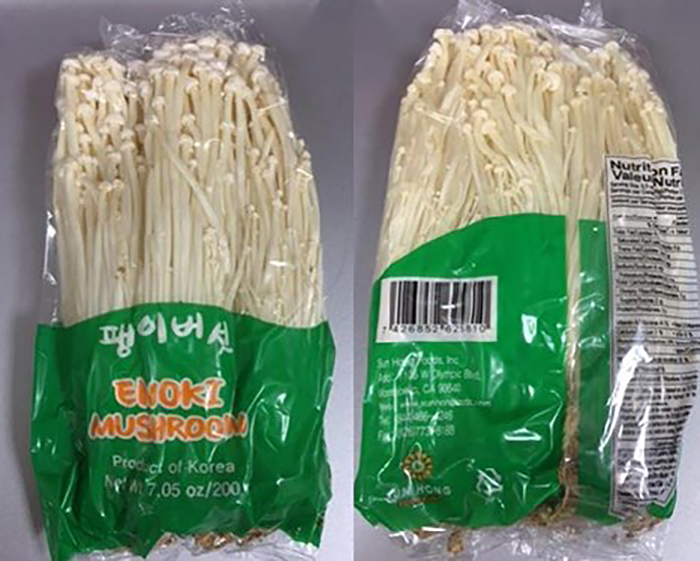 |
Since then, between March 2020 and May 2022, state public health authorities conducted sampling of enoki mushrooms from retail locations. L. mono was detected in multiple state samples, which led to 21 recalls of enoki mushrooms in the U.S. in 2021. Nine of the recalls were linked to enoki mushrooms grown in the ROK. During this time frame, the FDA collected and analyzed 93 samples of enoki mushrooms imported from the ROK for L. mono and found 31 violative shipments. This represents a violation rate of 33%. In terms of number of companies involved, there were 12 with violative product out of 29 that had exported shipments of enoki mushrooms to the U.S.
Based on these numbers for the ROK, the FDA believes that contamination of enoki mushrooms with Listeria monocytogenes is extremely unlikely to have been caused by an isolated incident. Further, the FDA's findings of L. mono strains with the same genomic sequence in multiple shipments over a period of time are consistent with resident pathogens in mushroom operations in the ROK. Evidence suggests that enoki mushrooms may be a high-risk reservoir for L. mono due to the difficulty in maintaining good hygienic practices at typical enoki mushroom production facilities.
Accordingly, the FDA considers enoki mushrooms imported from the Republic of Korea to appear “adulterated” under the Federal Food, Drug, and Cosmetic Act (FD&C Act) because they appear to contain Listeria monocytogenes. The text of Import Alert #25-12 further explains the apparent violation under the FD&C Act and describes the process for removal from DWPE, including how Korean producers may be added to the Green List of the alert.
|
|
|
Back to TOP

The European Food Safety Authority’s (EFSA) four-day ONE Conference 2022 in late June examined food and feed safety from the broader perspective of sustainable food systems, focusing on the need to implement a “One Health – One Environment” approach and exploring possible developments of risk assessment science. The Brussels event, which attracted government officials, scientists, and students alike, was co-sponsored by EFSA and its sister agencies — the European Centre for Disease Prevention and Control (ECDC), the European Chemicals Agency (ECHA), the European Environment Agency (EEA), the European Medicines Agency (EMA) — and the European Commission’s Joint Research Centre (JRC).
In addition to staff from our Europe Office, other FDA attendees included Steve Musser, deputy director of scientific operations at the Center for Food Safety and Applied Nutrition (CFSAN), and Don Prater, associate commissioner for imported food safety. Frank Yiannas, deputy commissioner overseeing the FDA’s Office of Food Policy and Response, presented virtually.
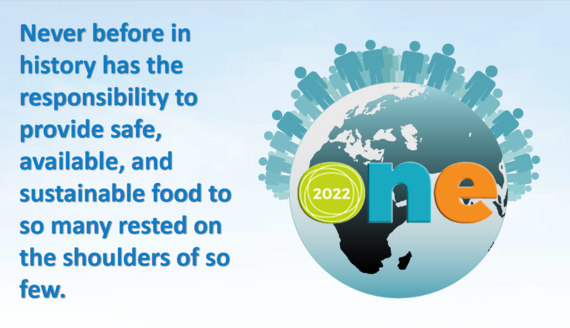 EFSA Commissioner Stella Kyriakides officially opened the conference. “EFSA has cemented the scientific basis for policy making and allowed us to maintain confidence in the EU food safety, raised standards, and driven cooperation to improve how risk assessment is done.”
For the FDA, Frank Yiannas spoke at the opening plenary session on the topic “Actions Speak Loudest/the Battle for Trust.” Using a broad lens, he described how such societal factors as global inflation, political scandals, the distribution of mis- and disinformation, and food scares are all contributing to what he identified as a “global consumer trust bust” and to increasing polarization in food viewpoints. “Food used to unite us, but today food is an issue that is dividing us,” he said, citing divisions like locally- vs. globally sourced, organic vs. conventional, or natural vs. processed.
To increase trust, he suggested adopting components of the FDA’s New Era of Food Safety. For example, addressing “anonymity” is a key issue to be reconciled: not knowing where a food comes from creates distrust. Tech-enabled traceability, as described in the New Era Plan, can rapidly trace food back to its source and thus facilitate better root cause analyses of contamination, creating greater transparency and greater trust. The FDA has proposed a food traceability rule mandated by the FDA Food Safety Modernization Act (FSMA). It would establish key data elements, allowing the creation of a universal language for food traceability and identifying critical tracing events in the food system, as well as defining the foods for which additional record keeping will be required. The agency is planning to issue the final rule in November, according to Yiannas.
Using smarter tools and approaches, such as employing the power of big data, will increase the FDA’s ability to predict and prevent outbreaks. Sharing such data will be useful for the entire food system, engendering smarter and safer practices, resulting in greater trust, Yiannas said. The promise of big data was also echoed by EFSA Executive Director Bernhard Url, who called upon agencies to “make sense of the abundance of insights, data, and knowledge.”
 The FDA's Frank Yiannas and Steve Musser spoke at the opening and closing plenary sessions, respectively.
Across the four days, concurrent breakout sessions were grouped by theme: One Society (human social influence), One Life (food, nutrition, microorganisms), One Planet (environment), and Many Ways (strategy, method, tool). Panel participants explored and debated solutions to today’s multiple food-related challenges. Descriptions of the sessions are posted on the ONE website, along with selected highlights, including:
- The need for an ecosystems approach.
- How to ensure our diets become healthier and more sustainable in a warming world.
- Integrating big data and artificial intelligence in food safety assessments.
- Developing a framework for sustainability assessments.
- Need for a paradigm shift in Environmental Risk Assessment of pesticides.
- How to develop approaches to assessing combined exposure to multiple chemicals.
- Using new methodologies to replace animal testing.
- Pandemic preparedness and the drivers for disease spread.
- Importance of a people-centered approach to plant health.
- How to best bridge the divide between research and policy.
- Relationship between microbiome, human, and environmental health.
- How to improve animal welfare to meet sustainability targets.
At the closing plenary session, Steve Musser provided an on-the-spot reaction to the session panelists and to the conference as a whole. Speaking from a U.S. vantage point, he reiterated one of the central themes of the meeting — the importance of making decisions that are informed by the latest scientific findings. Musser also participated in the Q&A with the session’s other panelists where he emphasized the need to make sure that data is shareable or interoperable across multiple sectors in order to produce the best risk assessments, using a process that is as open and transparent as possible. In this way, scientists and regulators will have a more complete understanding of how foodborne pathogens travel from the environment to food products and ultimately cause human or animal illness so they can employ targeted preventive controls that better prevent and respond to foodborne illness, he said.
In closing, Bernhard Url issued a uniting call to pursue increased integration in an actionable and collaborative way before future challenges overtake our means. Likewise, Pamela Byrne of the Food Safety Authority of Ireland, emphasized: “Break the silos, be collaborative, recognize what we know and don’t know. Be open with your data and be open in your mind to new ways of doing things. It’s not business as usual; it’s time to take action.”
 Don Prater (5th from left), Steve Musser (6th), EFSA Director Bernhard Url (7th), Ritu Nalubola (8th), and Alessandro FIorelli at far right. With the rest of the EFSA team joining them in the photo.
Epilogue:
FDA leadership took advantage of this visit to meet with their European public health colleagues. Steve Musser and Don Prater, accompanied by FDA Europe Office Director Ritu Nalubola and Foods Policy Specialist Alessandro Fiorelli, met with the leadership of various authorities over the course of the conference. These included: EFSA, German Federal Office of Consumer Protection and Food Safety, German Federal Institute for Risk Assessment, DG SANTE/European Commission, UK Food Standards Agency, and the industry organization FoodDrinkEurope.
In response to the preparedness and supply chain issues identified during the COVID-19 pandemic, the European Union established the European Health Emergency Preparedness and Response Authority (HERA) to anticipate threats and potential health crises, through intelligence gathering and building the necessary response categories.
“When an emergency occurs, the agency will ensure the development, production and distribution of medicines, vaccines, and other medical countermeasures — such as gloves and masks — that were often lacking during the first phase of the coronavirus response,” the European Commission (EC) said in a September 16, 2021, press release announcing the new agency, which is based in Brussels.
To further its work, in May of this year, HERA signed a Memorandum of Understanding with the U.S. Department of Health and Human Services and the EC’s DG Sante, Directorate-General for Health and Food Safety to collaborate on:
- Epidemic and supply chain information.
- The identification of promising solutions regarding research, innovation, and production of medical countermeasures, including vaccines, therapeutics, and diagnostics.
- Procurement activities, assessment of vaccine platforms, and exchange of best practices on vaccine arrangements.
- Mis- and disinformation of health threats.
Much of this work is likely to fall within the FDA’s purview.
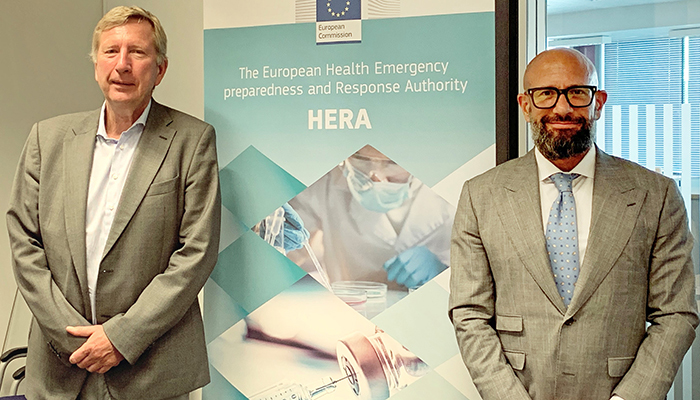 Seeing potential future opportunities for collaboration, Mark Abdoo, associate commissioner for global policy and strategy, earlier this month carved out time for a high-level get-acquainted meeting with HERA senior staff, including Director General Pierre Delsaux, when he traveled to Amsterdam and Brussels to meet with the European Medicines Agency (EMA) and DG Sante officials. The EMA is an agency of the European Union in charge of the evaluation and supervision of medicinal products. For his initial meeting with HERA, Abdoo said he wanted to get a better understanding of the agency’s mission, priorities, and role within the broader EC public health system. In turn, he provided HERA officials with an overview of the FDA’s international activities and its role within the U.S. government when a public health crisis occurs.
An FDA delegation led by Mark Abdoo, associate commissioner for global policy and strategy, held a series of meetings with European regulators on July 7-8.
On July 7, the FDA delegation met with Emer Cooke, executive director of the European Medicines Agency, at the EMA’s Amsterdam office to discuss their recent collaborative successes and consider potential new areas of collaboration. On July 8, in Brussels, the FDA delegation held separate meetings with food and medical product officials from the European Commission’s DG Sante, Directorate-General for Health and Food Safety.
 The EMA is an agency of the European Union in charge of the evaluation and supervision of medicinal products. DG Sante is responsible for EU policy on food safety and health and for monitoring the implementation of related laws.
The FDA and the EMA have been sharing information since signing a confidentiality arrangement in 2010 to protect nonpublic information. This arrangement opened the door for the creation of a series of working groups or clusters, which have become the bedrock of FDA and EMA engagement. Each of the more than 20 clusters focus on a special topic or therapeutic area that have been identified as requiring an intensified exchange of information and collaboration. Cluster participants identify bottom-up technical challenges, policy gaps, and real-world examples of public health matters best addressed collaboratively. In 2021, a new cluster was formed to further efforts to include pregnant and lactating individuals in clinical research.
The long-standing partnership between the FDA and the EMA has paid off during the COVID-19 pandemic, making it easier for the two agencies to work together to address a broad variety of public health issues involving antiviral drugs, vaccines, drug safety, and drug shortages, FDA officials said.
One of the topics that came up on July 8 during the meeting with Andrzej Rys, director of DG Sante B Health Systems, Medical Products and Innovation, was the Pharmaceutical Mutual Recognition Agreement or MRA. The agreement allows FDA and European regulatory agencies to rely on each other’s inspectional data. Currently the MRA is being applied to surveillance inspections including those conducted within our respective borders and for inspections of manufacturing facilities located outside our borders. It has been instrumental in helping to ensure continued oversight of foreign facilities when COVID-related travel restrictions have been in place.
As a result of the MRA, over the last two years, the FDA has been able to defer close to 300 inspections in Europe by relying on inspections conducted by EU partners. In the EU, inspections of manufacturing sites are carried out by national competent authorities from EU Member States. The EC and the EMA play an important role in coordinating these activities in collaboration with the Member States.
Other topics discussed included potential new areas of cooperation such as illicit trade in health products, advanced manufacturing and regulatory science, food outbreak response, and nutrition labeling. Nathalie Chaze, DG Sante’s director of food sustainability and international relations, led the DG Sante delegation for talks on food issues.
Public Health Advisors Kristan Callahan and Jade Pham from the Office of Trade, Mutual Recognition, and International Arrangements (OTMRIA) represented the FDA as part of the U.S. delegation to the World Trade Organization’s Technical Barriers to Trade (TBT) Committee meeting in Geneva, Switzerland from July 12-15.
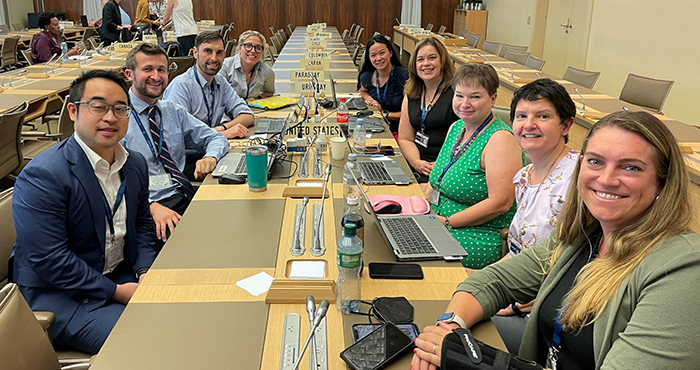 Kristan Callahan (left back) and Jade Pham (right back) as part of the U.S. delegation (led by USTR and includes FDA, NIST, FAS, and Commerce) to the WTO TBT Committee meeting.
The TBT Committee meeting provided an opportunity for WTO members and observers to discuss specific trade concerns — including specific laws, regulations or procedures that affect their trade — as well as ways to strengthen implementation of the TBT Agreement.
The TBT agreement is meant to ensure that technical regulations, standards, and conformity assessment procedures are nondiscriminatory and do not create unnecessary obstacles to trade. However, the agreement also recognizes the right of WTO members to implement measures to achieve legitimate policy objectives, such as the protection of human health and safety, or the environment.
In addition to attending the meeting, Callahan and Pham also participated in a related session on transparency. During the session, Callahan — in partnership with the USDA’s Foreign Agricultural Service and the National Institute of Standards and Technology — delivered a presentation from a regulator’s perspective on the domestic coordination of TBT notifications and responses.
FDA Outlined Food Safety Priorities during Seminar with Danish Industry
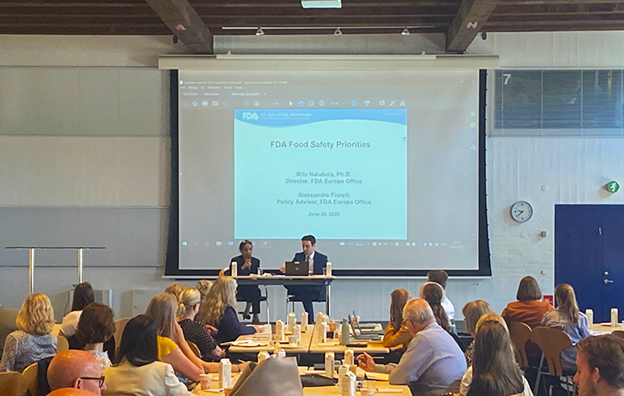 FDA Europe Office (EO) Director Ritu Nalubola and Food Policy Advisor Alessandro Fiorelli provided the Danish Food Industry Association with an overview and update of the FDA foods program on June 28 in Copenhagen. The Danish Embassy in Washington, D.C. organizes a one-day seminar with the EO every few years. Topics can vary from food or medical products depending on industry interest.
For the EO presenters, this ongoing series has been an opportunity to hear directly from industry, learn about the types of products exported to the U.S., and share the latest developments to support compliance with FDA requirements.
This year’s seminar focused on FDA food priorities: Foreign Supplier Verification Program implementation, New Era of Smarter Food Safety, food import requirements (e.g., Food Facility registration process, Prior Notice of imported food), import alerts, and the proposed rule for food traceability. Around 65 people attended the seminar, representing manufacturers of seafood, dietary supplements, cheese, and infant formula, as well as suppliers of food enzymes and other ingredients.
While in Copenhagen, Nalubola and Fiorelli also met with the Danish Veterinary and Food Administration (DVFA) to discuss recent developments on food safety and nutrition in the U.S. and in Denmark. Items discussed with DVFA included international food outbreaks and the use of Whole Genome Sequencing as a tool in outbreaks; New Era of Smarter Food Safety; the EU’s Farm-to-Fork Strategy and its implementation; front-of-pack food labeling; and an update on scientific and regulatory developments on cannabidiol, or CBD, in the U.S. and Europe.
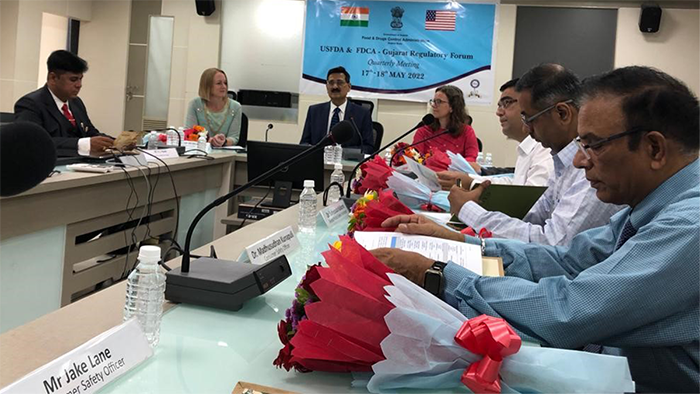 At the FDA and FDCA Gujarat Regulatory Forum.
On May 17-18, the FDA India Office (INO) participated in its second Regulatory Forum with the Gujarat Food and Drugs Control Administration (FDCA), one of India’s dozens of state regulatory authorities. The forum was hosted by the FDCA at its offices in Ahmedabad. Topics of discussion included food safety, inspections of food and drug facilities, and regulatory actions. The two regulatory authorities look to the forum as an opportunity for identifying initiatives for strategic collaboration on products they regulate that are exported to the U.S. from India.
The state of Gujarat is located on India’s western prominence along the Arabian Sea. Although it covers only 6% of the country’s area, the state is a medical products leader, accounting for a third of India’s pharmaceutical production and nearly half of the medical devices manufactured in the country.
 India Office staff (on right) visit L.M. College of Pharmacy.
While in Ahmedabad, INO staff visited with innovators who are converting their pharma and healthcare ideas into business startups at the state-of-the-art Atal Incubation Centre hosted by the L.M. College of Pharmacy and supported by the Atal Innovation Mission (AIM). AIM is the government of India’s lead initiative to “create and promote a culture of innovation and entrepreneurship” across the country; it is managed by the National Institution for Transforming India (known as NITI Aayog). During the INO's visit, faculty and students presented their products under development, seeking feedback and information on which FDA regulations may apply to them. Their innovations ranged from sanitizers for pets to living cell therapy for diabetic feet to novel platforms for delivering proteins and peptides. While they presented, the faculty and students were accompanied by wild peacock calls outside the open windows.
Also on the staff’s itinerary was a visit to the State Model Institute for Ayurveda Science (SMIAS) in nearby Gandhinagar, Gujarat, which serves as both a college and a hospital. Here, they discussed Ayurveda education and research with educators and physicians, as well as with regional officials from the FDCA. While there, they toured the SMIAS hospital to gain insight into the traditional Ayurveda system of medicine, which is focused on cultivating wellness and taking a holistic approach to practicing medicine. The visitors learned about and observed a wide range of therapies, treatments, and Ayurvedic principles as they toured the various departments of specialty at the facility, some quite foreign when viewed through a Western medicine lens.
 SMIAS staff welcome Drs. McMullen and Mickelsen for a tour of the facility.
 At the SMIAS hospital: (left to right) Ayurveda doctors describing a netra basti treatment for the patient’s dry eyes; McMullen observing janu basti treatments on patients with knee pain/stiffness; An Ayurvedic pharmacist dispensing traditional medicines.
FDA, EMA, Agree on Adapting Vaccines to Combat Virus Variants
 Experts from the FDA, the European Medicines Agency (EMA), and the World Health Organization (WHO) met last month to discuss emerging evidence and key principles that support adapting COVID-19 vaccines to better match Omicron variants and to ensure regulatory alignment globally.
The meeting, held on June 30, was the fourth in a series of workshops on COVID-19 vaccine development and virus variants held by the International Coalition of Medicines Regulatory Authorities (ICMRA). The event was co-chaired by Dr. Peter Marks, director of the Center for Biologics Evaluation and Research, and Dr. Marco Cavaleri, head of health threats and vaccines strategy at the EMA.
Global regulators who attended the meeting agreed that the currently authorized COVID-19 vaccines continue to offer protection against severe disease, hospitalization, and death and encouraged their use, both as primary series doses and boosters. The participants discussed preliminary data suggesting that adapted mRNA vaccines that incorporate an Omicron variant strain can increase protection when used as a booster.
However, the ICMRA and WHO experts also acknowledged that the ongoing evolution of SARS-CoV-2 reduces the protection against infection and mild disease offered by the approved vaccines. Though the Omicron BA.4 and BA.5 subvariants seem to be overtaking many parts of the world, new variants may emerge rapidly, replacing the current ones after short-lived waves.
Also discussed was the issue of the emerging data that indicate a bivalent mRNA vaccine targeting two strains of SARS-CoV-2 — one of which should be an Omicron strain — may provide advantages in expanding immune response.
The workshop participants stressed that evidence is still being collected and that emerging clinical data from the ongoing clinical trials should be carefully reviewed to determine the suitability of adapted vaccines. The participants also emphasized that effectiveness studies should be planned to determine the adapted vaccines’ level of protection from infection, hospitalization, and death in real-life conditions.
|
|
|
Back to TOP

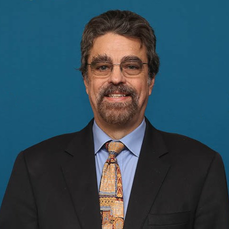
After nearly three years, Bruce Ross is stepping down as director of the Office of Global Policy and Strategy’s Office of Global Operations (OGO). OGO manages the FDA’s foreign offices in China, India, Latin America, and Europe, as well as interactions with other locations where the FDA does not have a foreign presence.
Mark Abdoo, associate commissioner for global policy and strategy, made the announcement on July 21 in an email to staff.
“Please join me in thanking Bruce for his leadership and commitment to global health,” Abdoo said. “Under Bruce’s leadership, OGO has accomplished much and taken on challenges FDA had never faced before, such as repatriating staff of the China office at the beginning of the COVID pandemic.”
“Fortunately, Bruce will not be going far,” Abdoo added, saying that Ross has “graciously agreed” to remain in the Office of Global Policy and Strategy and bring his 20-plus years of field experience with the Centers for Disease Control and Prevention and the FDA to the international relations specialist position for the Latin America Office (LAO) in Santiago, Chile. That role is tasked in part with OGPS’ strategic aquaculture and whole genome sequencing engagements.
“In global offices such as OGPS there are headquarters people and field people. Both are essential to achieving the mission,” Abdoo said. “As you may have guessed given his long record in the field, Bruce is a field person. I commend him for sticking out seven years in various headquarters positions with ORA (Office of Regulatory Affairs) and OGPS and am glad that in his waning years of government service he is able to return to the field.”
The transition will occur over the coming few months, with Ross ending his tenure as OGO director at the end of the fiscal year and moving to Chile in early October. In light of these changes, Abdoo is transitioning oversight of the Latin America office to himself, including supervisory responsibility for LAO Director Katie Serrano, effective immediately.
|
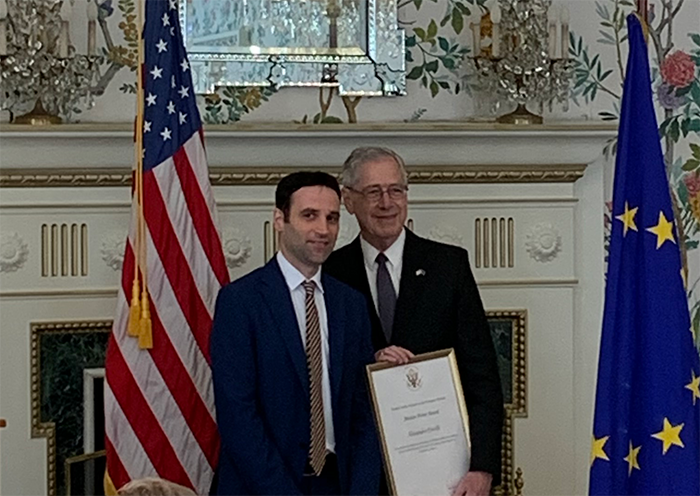 The FDA’s Alessandro Fiorelli receives U.S.-EU Meritorious Honor Award from U.S. Ambassador to the EU, Mark Gitenstein.
On June 15, Europe Office (EO) International Policy Advisor Alessandro Fiorelli was awarded the U.S.-EU Meritorious Honor Award for his significant contributions to shellfish trade.
The award was presented by U.S. Ambassador to the EU Mark Gitenstein at the U.S. Embassy in Brussels in recognition of Fiorelli’s “exemplary and outstanding contributions enabling the resumption of trade in shellfish between the U.S. and the EU, ending a decade-long ban in transatlantic commerce.”
Fiorelli’s exceptional performance and persistence helped ensure the successful negotiation between the FDA and DG SANTE (the European Commission’s Directorate-General for Health and Food Safety) of procedures for restarting and continuing trade in molluscan shellfish for years to come. To the delight of industry, trade finally restarted in February 2022 after being banned since 2010, unlocking economic opportunity for both U.S. and EU exporters and making a wider selection of safe shellfish products available to consumers.
His knowledge of the EU legal system and the EU regulation of shellfish helped the FDA to develop effective negotiating positions throughout the multi-year, protracted effort to reopen shellfish trade. Fiorelli’s efforts will help going forward as well. As part of the negotiations, the U.S. and the European Commission agreed to launch a technical working group to collaborate on shellfish safety. Fiorelli is a point of contact for this technical working group and will continue to support the FDA’s future work.
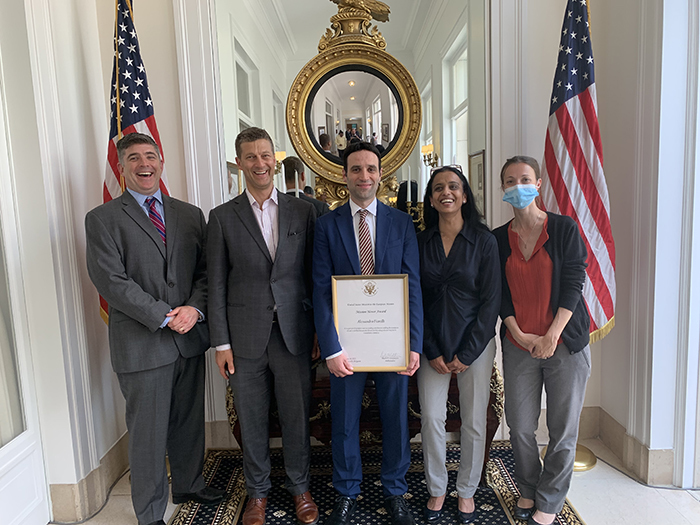 Members of the FDA’s Europe Office share their enthusiasm for Fiorelli’s award. Left to right: Kerry Mannion, agent in charge for the FDA’s Office of Criminal Investigations, who was on temporary assignment in Brussels; International Relations Specialist Matthew Scherer; International Policy Advisor Alessandro Fiorelli (holding his award); Europe Office Director Ritu Nalubola; and International Policy Advisor Claudia Louati.
India Office Receives Award for CC with MPEDA
The FDA India Office (INO) Food Team received an Embassy Meritorious Honor award for the signing of a confidentiality commitment (CC) with India’s Marine Products Export Development Agency, known as MPEDA. The award was presented on May 27 by Patricia Lacina, Charge d’ Affaires, to Dr. Pankaja Panda, INO’s Food Safety Coordinator, who accepted the award for the team.
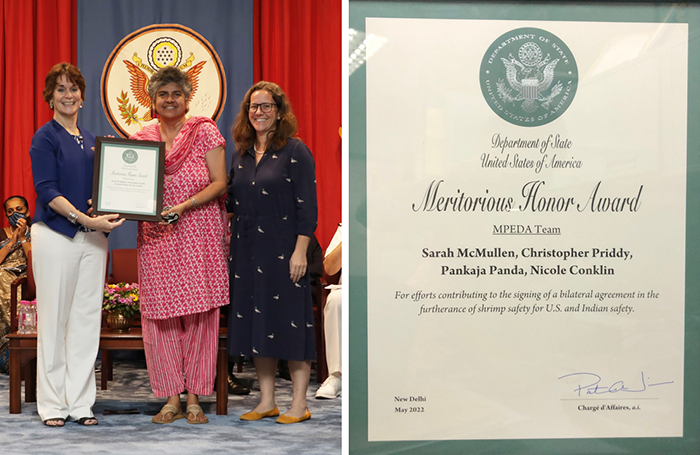 The citation on the award reads “For efforts contributing to the signing of a bilateral agreement in the furtherance of Shrimp Safety for U.S. and Indian safety” and it names Office of Global Policy and Strategy (OGPS) staff who led INO’s longstanding efforts toward finalizing this CC. Honorees included INO Director Dr. Sarah McMullen, Dr. Pankaja Panda, International Policy Analyst Cmdr. Nicole Conklin, and International Relations Specialist Christopher Priddy, formerly with OGPS.
This CC, a bilateral collaborative effort with MPEDA, opens the doors for deeper work between our two agencies on seafood issues as a whole, including shrimp safety.
When Matt Scherer began his FDA career in 2007 — in the essential yet undercelebrated medicinal area of cathartics, laxatives, and gastrointestinal drugs — he seemed an unlikely candidate to be an international program and policy analyst based in the FDA Europe Office (EO) in Brussels.
But just consider his upbringing, and you realize he’s been auditioning for his OGPS roles for a long time.
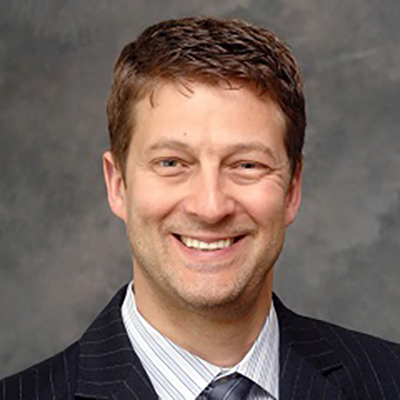
Exposed to international travel at an early age with his family in Wisconsin, Matt grew up with an awareness of a world outside of the United States. He later went on to enjoy several foreign adventures as a young adult. One journey involved spending six weeks in sub-Saharan Africa, including Kenya, Tanzania, and Uganda.
“Spending time in an area so starkly different, it made me appreciate what a world this is — the beauty of it, and how good people are,” said Matt.
Similarly, his interest in research had early beginnings. “From a ‘youngin,’ I was a science and math guy,” he said. After receiving a Bachelor of Science in molecular biology at the University of Wisconsin, Matt took a mundane job in a pharmaceutical control lab. With no advancement opportunities in sight, he decided to move on after a couple of years and attend graduate school at Georgetown University, where he earned an MBA.
One of his MBA requirements was to participate in an international consulting project with Citibank Vietnam. Matt and his colleagues developed recommendations on how the Vietnamese seafood industry could increase exports to the U.S. vis-à-vis the normalizing of trade relations that had begun in the 1990s and the anticipated bilateral trade agreement between the two countries.
“Citibank organized a conference for the industry around our project in Can Tho that included a presentation of our analysis and recommendations, as well as targeted workshop sessions to provide more depth on specific recommendations,” said Matt. “It was awe-inspiring to present to such a large and ‘hungry’ audience halfway around the world — simultaneous translation made it more interesting as well. And, it was very cool to see our names and pictures in the local paper the next day.”
“Of course, I tacked on some additional time to visit more of South Vietnam, as well as Cambodia and Thailand,” added Matt.
After doing consulting work in areas related to marketing research and biotechnology, Matt spent a few years in a lucrative position involving commodities. “I was getting away from the science,” said Matt. “It kept me thinking about returning to pharma.”
|
 Matt and his family visiting Slovenia in 2017.
Finally, a dinner conversation with his wife — who also works in medicine — and a friend who had just been hired by the FDA convinced Matt to make a career change and enter federal service. In 2007, he went to work at the FDA as a regulatory health project manager. “It just felt good, having a mission I can believe in,” he said.
Before undertaking his assignment in 2016, Matt was already handling domestic coordination with the FDA’s Beltway-based European community from White Oak. “I’ve always had a fundamental interest in working overseas,” said Matt. “So, I kept my ear to the ground for a couple of years.”
The nearly six-year international tour has translated to personal enrichment for Matt and his family. For one, the location of the EO in Brussels has been crucial to Matt experiencing myriad travel adventures across Europe, including a three-week beach vacation in Portugal, memorable trips to Hungary and Norway, and even journeys to less frequented destinations like Slovenia.
“One can get to so many places so easily,” said Matt. “I’ve seen places that I never would have otherwise visited.”
Matt and his wife Emily have also instilled this spirit of adventure and curiosity in their two sons, both of whom have become fluent in French. The boys go to school with children who speak Hungarian, Italian, and other languages, which has been “ultimately, very good for them.” “They have American friends, but most of their friends speak other languages,” said Matt. “Diversity is normal.”
His professional life has been similarly enhanced. Much of Matt’s work at the EO involves engaging routinely with high-level foreign government representatives to ensure effective collaboration and information sharing, as well as developing and maintaining relationships with key interlocutors at European Union and Member State institutions, including the European Medicines Agency.
 Matt presents at a meeting in Heidelberg, Germany.
More recently, serving in an interface role in the interagency U.S. mission to the European Union (EU), Matt has been responsible for explaining FDA policy positions and activities and ensuring a cohesive U.S. government response on issues that intersect with the agency. A significant portion of his portfolio has been developing and implementing the FDA’s pharmaceutical mutual recognition agreements (MRA) with the EU and the United Kingdom. In June, Matt received an OPLIA Special Recognition award for sustained excellence and commitment to MRA activities.
He has also conducted briefings at the Ambassador and “Chargé d’Affairs” level, worked with public affairs staff to ensure public messaging is consistent with FDA positions, reviewed and approved electronic country clearances, and represented the agency at budget committee and interagency staff meetings. Prior to the pandemic, Matt found great satisfaction traveling regionally for the agency and helping develop relationships with member states while working on mutual priorities.
“It’s really stimulating to be able to represent your agency abroad,” said Matt. “My European counterparts are very modern and care about public health. We’re working together to achieve the same goals.”
Now, after Matt and his family finish organizing several years’ worth of accumulated belongings and prepare to return to the U.S., he describes the accompanying emotions as “mixed and bittersweet.” Though they are looking forward to reconnecting with old friends and moving into a newly purchased home in Maryland, Brussels has become home for his sons.
However, Matt is excited to begin the new adventures that await him upon his return to White Oak. He will remain with OGPS and join its Office of Trade, Mutual Recognition, and International Arrangements to help develop the FDA’s multilateral engagement portfolio while supporting the Europe Office on remaining EU Member States veterinary drugs capability assessments. His fellow OGPS colleagues at headquarters are eager to draw on his vast knowledge of the FDA’s mutual recognition activities, as well as his historical knowledge and insights into European regulatory culture.
|
|
|
Back to TOP
 Laterals

Phil Nguyen, M.D.
Dr. Phuc (Phil) Nguyen has moved from the OGO Immediate Office to the India Office as the new international relations specialist for bioresearch monitoring — work that involves monitoring the conduct and reporting of FDA-regulated research to ensure the quality and integrity of data submitted to the agency. He will provide technical expertise and reporting, liaise with the FDA’s medical product centers, and facilitate engagements and information sharing with FDA staff, industry, and counterpart regulators. He is currently on TDY in India, helping with outreach to the Government of India and clinical research organizations there. He will make a permanent move to New Delhi later this year.
Dr. Nguyen comes to OGPS from CDER, where he has been a physician for the FDA’s Biomedical Research Monitoring Program. He started with the FDA as an ORISE Fellow in OGPS’ previous incarnation, the Office of International Programs.
Outside of work, he enjoys traveling and cooking different cuisines. Wherever he goes, he always hopes to find like-minded jazz musicians to jam with — to rekindle his former life as an occasional lounge singer (including on a cruise ship!), so many years ago.
|
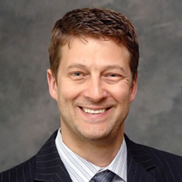
Matthew Scherer
Matthew Scherer has left the Europe Office (EO) after six years at our Brussels post. Among his many accomplishments, Scherer worked tirelessly and showed unflagging commitment to the success of the FDA’s mutual recognition activities, according to EO Director Ritu Nalubola. Scherer used his experience and knowledge of the evolution of the Mutual Recognition Agreement (MRA) with the European Union to further its implementation and growth. His deep knowledge of the European landscape and regulatory culture have been a credit to the EO, OGPS, and more broadly to FDA-EU relationships, she said. In the past year, his skills have been invaluable as OGPS continues to further its MRA work.
Scherer will remain with OGPS based at White Oak as an international policy analyst with the Office of Trade, Mutual Recognition, and International Arrangements, specializing in MRAs, so OGPS may continue to benefit from his historical knowledge and insights. In addition, he will continue to support the EO on the remaining EU-Member States veterinary drugs capability assessments.
|
On Detail

Lisa Lopez
One of the FDA’s Pioneer’s is coming back to an FDA foreign office – at least on detail in the FDA China Office.
Lisa Lopez, a supervisor in the Office of Regulatory Affairs’ National Quality Management System office, will be assuming Latasha Robinson’s duties as China Office deputy director so that Robinson can serve as acting director while Director Vanessa Shaw-Dore is on home leave.
The FDA Pioneer Award is reserved to those FDA staffers who participated in the opening of one of the FDA’s foreign offices. Lopez received the award because she helped open FDA’s Latin America Office in Costa Rica and served there as assistant regional director and in multiple details as deputy director and regional director over a five-year period from 2009-2014.
While overseas, Lopez received special recognitions from the State and Commerce Departments for leading the negotiations that led to Costa Rica’s government recognition of FDA’s clearance and approval of medical devices.
Lopez started her government career in 2000 as an FDA investigator in the Minneapolis District’s Milwaukee Resident Post and held a variety of positions for the Investigations Branch including serving a yearlong detail as acting director of investigations for the San Juan District. Prior to joining the FDA, she held managerial positions in quality and regulatory affairs in the pharmaceutical, cosmetics, and medical device industries.
Lopez has a B.S. in industrial chemistry from the University of Puerto Rico and has pursued graduate studies in organic chemistry and modern manufacturing systems.
|
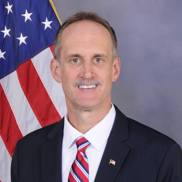
Doug Shaffer, M.D.
Dr. Douglas Shaffer joined OGPS on a 120-day detail at White Oak to provide operational and strategic support to the African Medicines Agency — a new and evolving public health partner, to be based in Rwanda. Prior to this detail, he had returned to the Department of Health and Human Service’s Office of Global Affairs after serving as the health attaché at the U.S. Embassy in Nairobi, Kenya.
Dr. Shaffer is an internationally recognized clinical research expert with over 20 years of experience in Africa spanning 12 sub-Saharan countries. As health attaché in Kenya, he was the principal public health and biomedical research advisor to the Ambassador regarding the U.S. government’s health and humanitarian assistance portfolio. He served as lead for the USG/Government of Kenya Bilateral Strategic Dialogue Health Cooperation Pillar and primary interlocutor to the Kenya Ministry of Health Cabinet Secretary. He also coordinated the embassy’s COVID-19 response efforts throughout most of the pandemic in Kenya.
His previous leadership positions include director of the U.S. Army Medical Research Directorate-Africa at the Walter Reed Army Institute of Research-Kenya; chief medical officer at the Office of the U.S. Global AIDS Coordinator and Health Diplomacy at the U.S. Department of State; and director of the U.S. Centers for Disease Control and Prevention-Rwanda program. From 2000-2004 Dr. Shaffer was a medical officer in the FDA’s Center for Drug Evaluation and Research.
Dr. Shaffer is a graduate of the West Virginia University Schools of Pharmacy and Medicine with active American Board of Internal Medicine certification and licensures (Pharmacy and Medicine). He completed clinical research training at the National Institutes of Health while obtaining a Master of Health Sciences in Clinical Research from Duke University School of Medicine. In both Kenya and Rwanda, Dr. Shaffer practiced patient care and taught medical education. He currently serves as an attending physician in the Department of Medicine at the Walter Reed National Military Medical Center in Bethesda, Maryland.
|
Departing

Heather Messick, J.D.
Heather Messick has left the Europe Office (EO) as an international policy analyst based at White Oak for a new position as a regulatory counsel in the Center for Drug Evaluation and Research’s Office of Compounding Quality and Compliance.
During her three-year tenure with OGPS, Messick worked on a diverse array of policy topics, including issues involving European data law and their impact on FDA activities. Most notably, Heather became the office lead on the European General Data Protection Regulation (GDPR), which could pose a range of potential consequences for the FDA and for clinical research. As the agency’s most knowledgeable source on the subject, Messick held numerous meetings with FDA centers, offices, and legal staff to help agency officials better understand the real and potential implications of the law for FDA programs. She also closely coordinated with the National Institutes of Health on the topic. “Her detailed, insightful summary of the GDPR will continue to inform the FDA’s advocacy on this issue within the interagency, at USEU, and with EU colleagues,” EO Director Ritu Nalubola said.
Messick holds a Juris Doctor from the University of Baltimore School of Law, with a concentration in public service, specializing in government service and regulatory institutions. She joined the FDA in 2014 as an ORISE Fellow in the Office of Emergency Management, then moved to the Office of Compliance in the Center for Tobacco Products for a few years before starting in the EO in 2018.
|

Laurimer Kuilan-Torres
Laurimer Kuilan-Torres, a drug investigator with the China Office (CNO) since March 2019, has returned to the United States to continue her FDA career as a pharmaceutical scientist at the Center for Drug Evaluation and Research’s Office of Pharmaceutical Quality/Office of Pharmaceutical Manufacturing Assessment/Division of Pharmaceutical Manufacturing.
The CNO thanks Kuilan-Torres and her family for her dedication and hard work while conducting inspections, investigations, and Remote Regulatory Assessments. During her time in China, she traveled extensively throughout the mainland to perform this work, which resulted in many enforcement actions, including regulatory meetings, a warning letter, import alerts, and drug application withholds.
|
|
|
|
Back to TOP
 Recent communications from OGPS to our international stakeholders (list does not include twice-weekly FDA Roundup summaries), mid-June through July.
|
|
|
Back to TOP

| August |
National Immunization Month
|
| August 18-19 |
CDER SBIA Webinar: Regulatory Best Practices for Global Access to Medicines, including anti-TB medicines
|
| August 25 |
Second Annual Meeting of Food Safety Partnership with Mexico’s SENASICA and Cofepris in Mexico City
|
| September 12-16 |
International Medical Device Regulatory Forum’s 22nd Management Committee Meeting in Sydney, Australia
|
| September 15-16 |
FDA-OECD meeting in Paris on Whole-of-Government approach to illicit products
|
|
|
Read thought-provoking pieces covering international topics in
From A Global Perspective. |
|
Please follow @FDA_Global. |
|
|
Subscribe to Global Update
Don't miss out on future issues of Global Update or other international news from OGPS. To sign up, click "Manage Subscriptions" in the below footer then follow the prompts and select the "International Programs" box.
|
|
|
|
|